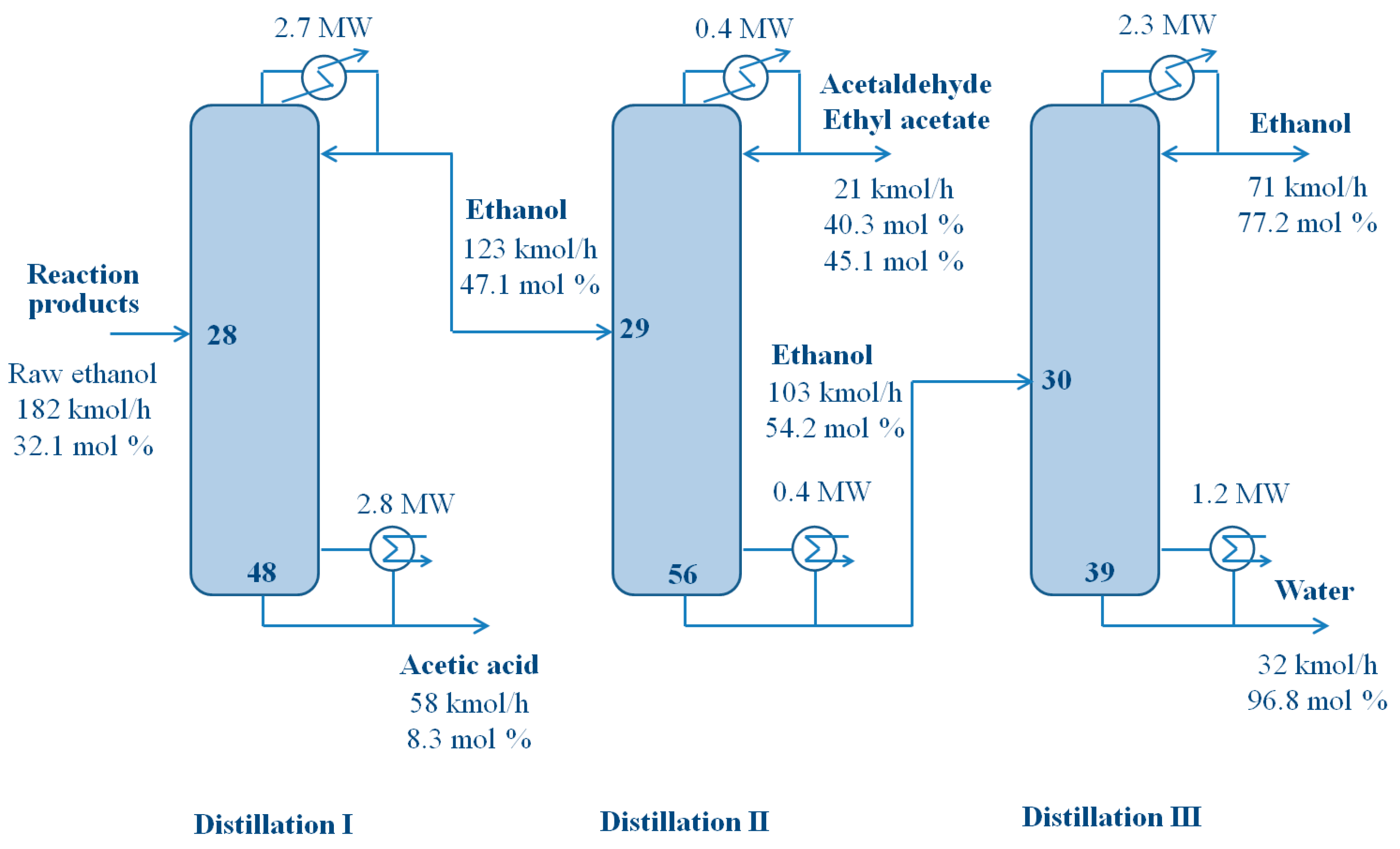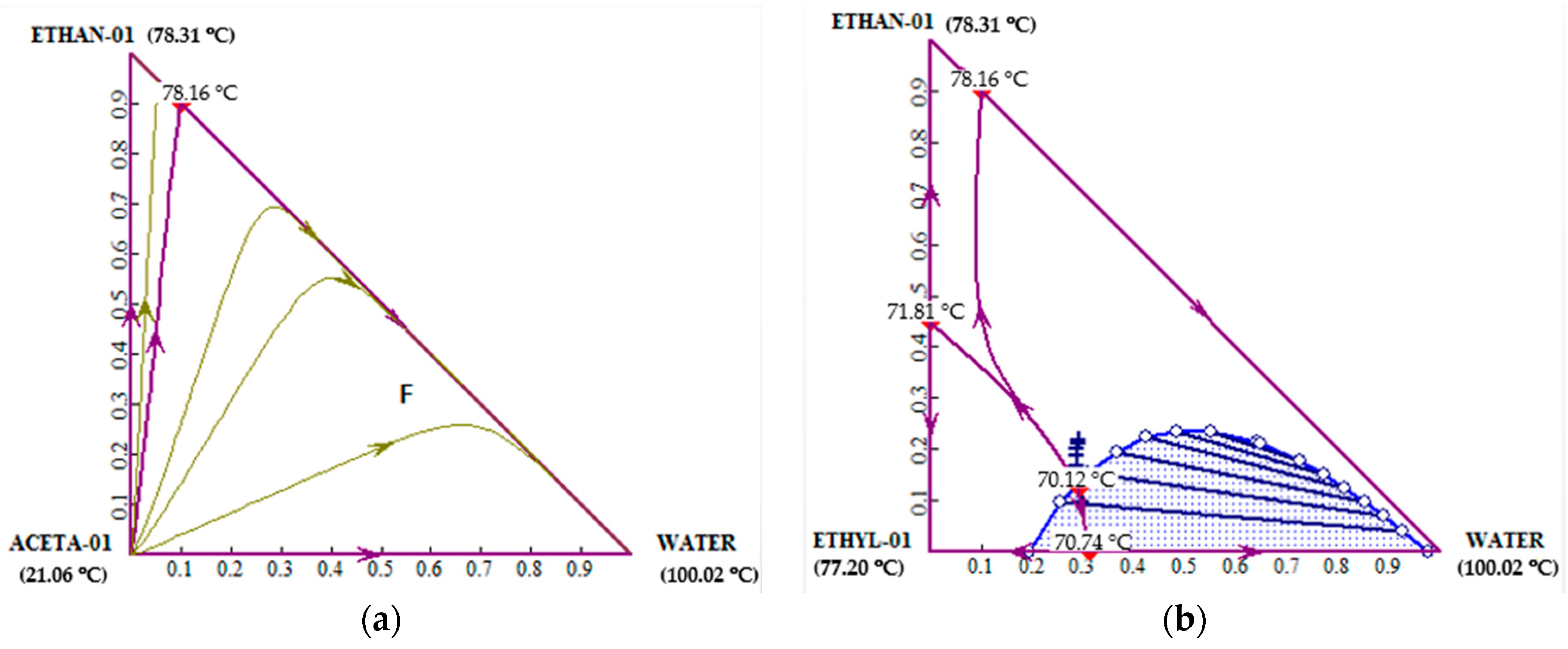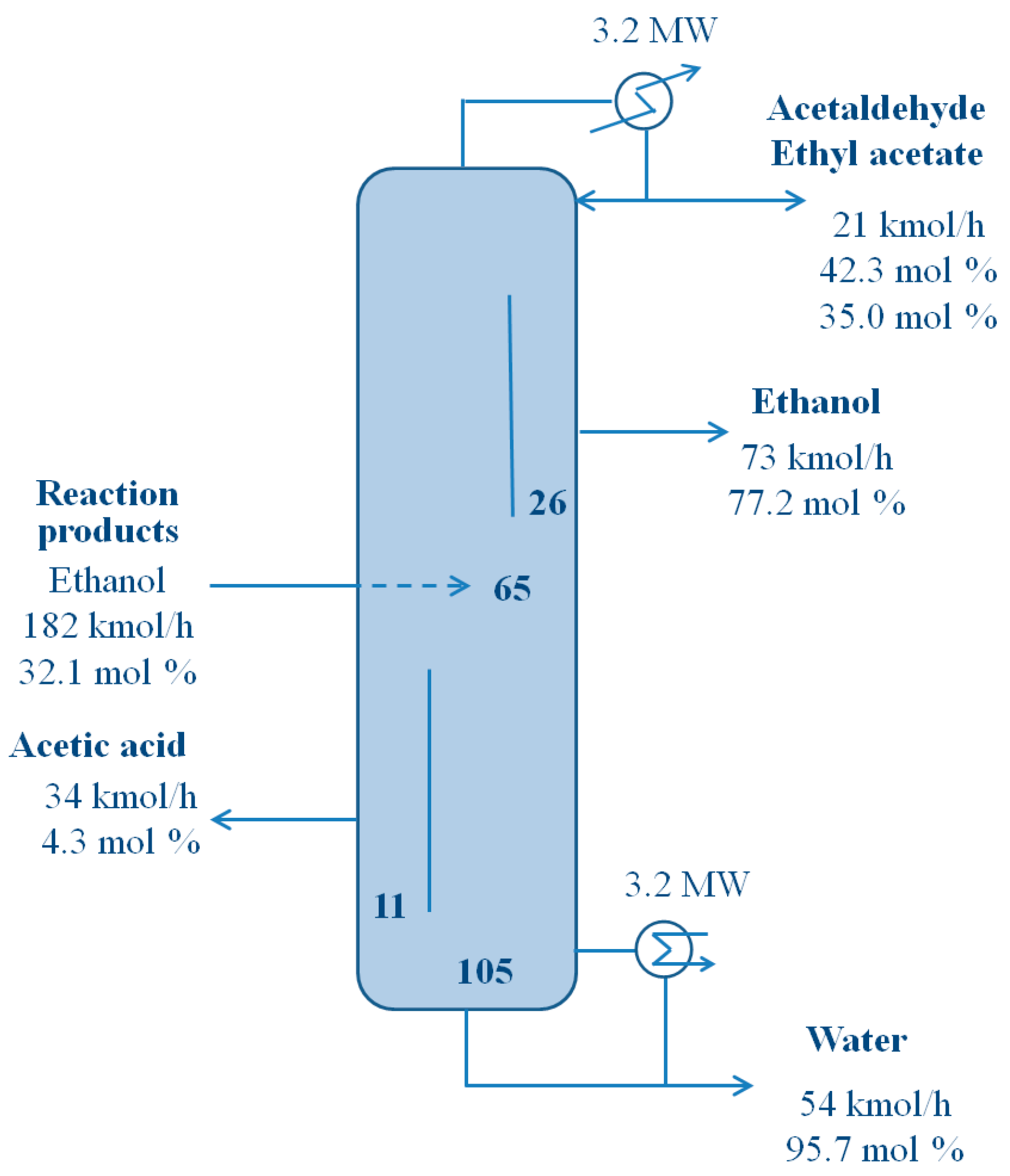Energy Efficiency Improvement in a Modified Ethanol Process from Acetic Acid
Abstract
:1. Introduction
2. Process Overview
3. Process Design
4. Results and Discussion
4.1. Design Results
4.2. Economic Evaluation
4.3. Exergy Loss and Thermodynamic Efficiency
5. Conclusions
Acknowledgments
Conflicts of Interest
Appendix A
References
- Saka, S.; Minami, E.; Rabemanolontsoa, H.; Kawamoto, H. Advanced biotethanol production process with acetic acid fermentation from lignocellulosics. In Proceedings of the 2014 Grand Renewable Energy International Conference, Tokyo, Japan, 27 July–1 August 2014.
- Kang, Q.; Baeyens, J.; Tan, T.W.; Dewil, R. A novel sintered metal fiber microfiltration of bio-ethanol fermentation broth. Korean J. Chem. Eng. 2015, 32, 1625–1633. [Google Scholar] [CrossRef]
- Baeyens, J.; Kang, Q.; Appels, L.; Dewil, R.; Lv, Y.Q.; Tan, T.W. Challenges and opportunities in improving the production of bio-ethanol. Prog. Energy Combust. Sci. 2015, 47, 60–88. [Google Scholar] [CrossRef]
- Gupta, A.; Verma, J.P. Sustainable bio-ethanol production from agro-residues: A review. Renew. Sustain. Energy Rev. 2015, 41, 550–567. [Google Scholar] [CrossRef]
- Howard, M.J.; Jones, M.D.; Roberts, M.S.; Taylor, S.A. C1 to Acetyls—Catalysis and Process. Catal. Today 1993, 18, 325–354. [Google Scholar] [CrossRef]
- Sunley, G.J.; Watson, D.J. High productivity methanol carbonylation catalysis using iridium—The Cativa (TM) process for the manufacture of acetic acid. Catal. Today 2000, 58, 293–307. [Google Scholar] [CrossRef]
- Global Data. Acetic Acid: World Supply Outweighs Demand; Global Data: London, UK, 2011. [Google Scholar]
- Zhang, S.; Duan, X.; Ye, L.; Lin, H.; Xie, Z.; Yuan, Y. Production of ethanol by gas phase hydrogenation of acetic acid over carbon nanotube-supported Pt-Sn nanoparticles. Catal. Today 2013, 215, 260–266. [Google Scholar] [CrossRef]
- Ito, Y.; Kawamoto, H.; Saka, S. Efficient and selective hydrogenation of aqueous acetic acid on Ru-Sn/TiO2 for bioethanol production from lignocellulosics. Fuel 2016, 178, 118–123. [Google Scholar] [CrossRef]
- Zhou, M.; Zhang, H.; Ma, H.; Ying, W. The catalytic properties of K modified PtSn/Al2O3 catalyst for acetic acid hydrogenation to ethanol. Fuel Process. Technol. 2016, 144, 115–123. [Google Scholar] [CrossRef]
- Goicoechea, S.; Kraleva, E.; Sokolov, S.; Schneider, M.; Pohl, M.-M.; Kockmann, N.; Ehrich, H. Support effect on structure and performance of Co and Ni catalysts for steam reforming of acetic acid. Appl. Catal. A Gen. 2016, 514, 182–191. [Google Scholar] [CrossRef]
- Loy, Y.Y.; Lee, X.L.; Rangaiah, G.P. Bioethanol recovery and purification using extractive dividing-wall column and pressure swing adsorption: An economic comparison after heat integration and optimization. Sep. Purif. Technol. 2015, 149, 413–427. [Google Scholar] [CrossRef]
- Li, J.; You, C.J.; Lyu, Z.X.; Zhang, C.; Chen, L.F.; Qi, Z.W. Fuel-based ethanol dehydration process directly extracted by gasoline additive. Sep. Purif. Technol. 2015, 149, 9–15. [Google Scholar] [CrossRef]
- Aniya, V.; Singh, A.; De, D.; Satyavathi, B. An energy efficient route for the dehydration of 2-Methylpropan-2-ol: Experimental investigation, modeling and process optimization. Sep. Purif. Technol. 2015, 156, 738–753. [Google Scholar] [CrossRef]
- Marty, P.; Hetet, J.F.; Chalet, D.; Corrignan, P. Exergy analysis of complex ship energy systems. Entropy 2016, 18, 127. [Google Scholar] [CrossRef]
- Mistry, K.H.; Lienhard, J.H. Generalized least energy of separation for desalination and other chemical separation processes. Entropy 2013, 15, 2046–2080. [Google Scholar] [CrossRef]
- Mistry, K.H.; McGovern, R.K.; Thiel, G.P.; Summers, E.K.; Zubair, S.M.; Lienhard, J.H. Entropy generation analysis of desalination technologies. Entropy 2011, 13, 1829–1864. [Google Scholar] [CrossRef] [Green Version]
- Warner, R.J.; Amleh, W.; Grusendorf, G.; Horton, T.; Jevtie, R.; Johnston, V.J.; Olsson, F.R.; Powell, N.K.; Salado, M.; Sarager, L. Process for Producing Ethanol Using an Extractive Distillation Column. U.S. Patent 8,304,587 B2, 6 November 2012. [Google Scholar]
- Kim, Y.H. Energy saving of benzene separation process for environmentally friendly gasoline using an extended DWC. Energy 2016, 100, 58–65. [Google Scholar] [CrossRef]
- Kim, Y.H. Energy saving in benzene-toluene-xylene separation process using extended divided wall column. Chem. Eng. Technol. 2016, 39. [Google Scholar] [CrossRef]
- Kiss, A.A.; Suszwalak, D.J.P.C. Enhanced bioethanol dehydration by extractive and azeotropic distillation in dividing-wall columns. Sep. Purif. Technol. 2012, 86, 70–78. [Google Scholar] [CrossRef]
- Kiss, A.A.; Suszwalak, D.J.P.C. Innovative dimethyl ether synthesis in a reactive dividing-wall column. Comput. Chem. Eng. 2012, 38, 74–81. [Google Scholar] [CrossRef]
- Kim, Y.H. Side-rectifier divided wall column for offshore LNG plant. Sep. Purif. Technol. 2015, 139, 25–35. [Google Scholar] [CrossRef]
- Naqvi, S.N. Ethanol Production by Celanese Acetyl Technolgy; Process Economics Program; SRI Consulting: Menlo Park, CA, USA, 2011. [Google Scholar]
- Abrams, D.; Prausnitz, J. Statistical thermodynamics of liquid mixtures: A new expression for the excess Gibbs energy of partly or completely miscible systems. AIChE J. 1975, 21, 116–128. [Google Scholar] [CrossRef]
- Binous, H. Liquid-liquid equilibrium and extraction using mathematica. Comput. Educ. J. 2006, 16, 78–81. [Google Scholar]
- Widagdo, S.; Seider, W.D. Azeotropic distillation. AIChE J. 1996, 42, 96–130. [Google Scholar] [CrossRef]
- Kim, Y.H. Design and control of energy-efficient distillation columns. Korean J. Chem. Eng. 2016, 33, 2513–2521. [Google Scholar] [CrossRef]
- Goff, P.; Cachot, T.; Rivero, R. Exergy analysis of distillation processes. Chem. Eng. Technol. 1996, 19, 478–485. [Google Scholar] [CrossRef]
- Suphanit, B.; Bischert, A.; Narataruksa, P. Exergy loss analysis of heat transfer across the wall of the dividing-wall distillation column. Energy 2007, 32, 2121–2134. [Google Scholar] [CrossRef]
- De Koeijer, G.; Rivero, R. Entropy production and exergy loss in experimental distillation columns. Chem. Eng. Sci. 2003, 58, 1587–1597. [Google Scholar] [CrossRef]
- Anozie, A.N.; Osuolale, F.N.; Osunleke, A.S. Exergy analysis of binary plate distillation column operations. Int. J. Exergy 2009, 6, 715–728. [Google Scholar] [CrossRef]
- King, C.J. Separation Processes; McGraw-Hill: New York, NY, USA, 1971; pp. 625–633. [Google Scholar]
- Kim, Y.H. Application of partially diabatic divided wall column to floating liquefied natural gas plant. Energy 2014, 70, 435–443. [Google Scholar] [CrossRef]
- Olujic, Z.; Sun, L.; de Rijke, A.; Jansens, P.J. Conceptual design of an internally heat integrated propylene-propane splitter. Energy 2006, 31, 3083–3096. [Google Scholar] [CrossRef]
- Douglas, J.M. Conceptual Design of Chemical Processes; McGraw-Hill: New York, NY, USA, 1988. [Google Scholar]
- Turton, R.; Baille, R.C.; Whiting, W.B.; Shaeiwitz, J.A. Analysis, Synthesis, and Design of Chemical Processes, 2nd ed.; Prentice Hall: Upper Saddle River, NJ, USA, 2003; pp. 196–210. [Google Scholar]




| Components | Molar Rate |
|---|---|
| Acetaldehyde | 12.583 |
| Ethyl acetate | 10.712 |
| Ethanol | 58.198 |
| Water | 95.105 |
| Acetic acid | 4.897 |
| Total | 181.5 |
| Variable | Conventional Distillation Columns | Extended DWC (Divided Wall Column) | ||||
|---|---|---|---|---|---|---|
| I | II | III | Main | Auxil. I | Auxil. II | |
| Structural | ||||||
| Tray No. | 48 | 56 | 39 | 105 | 26 | 11 |
| Feed/Side | 28 | 29 | 30 | 65 | 13 | 9 |
| Interlinking | 18/42 | 71/85 | ||||
| Operating | ||||||
| Pressure (MPa)—top | 1.5 | 1.2 | 1.1 | 1.2 | 1.25 | 1.3 |
| Temperature (°C) | ||||||
| Overhead | 100 | 50 | 79 | 66 | 78 | 94 |
| Bottom | 120 | 96 | 90 | 113 | 83 | 105 |
| Feed (kmol/h) | 182 | 124 | 103 | 182 | ||
| Product (kmol/h) | ||||||
| Overhead | 124 | 21 | 71 | 21 | ||
| Bottom | 58 | 103 | 32 | 54 | ||
| Side | 73 | 34 | ||||
| Reflux (kmol/h) | 136 | 24 | 148 | 321 | 95 | 74 |
| Vap. boilup(kmol/h) | 264 | 39 | 104 | 294 | 140 | 105 |
| Cooling duty (MW) | 2.7 | 0.4 | 2.3 | 3.2 | ||
| Reboiler duty (MW) | 2.8 | 0.4 | 1.2 | 3.2 | ||
| Comp. (mol frac.) Feed | ||||||
| Ethanol | 0.321 | 0.471 | 0.542 | 0.321 | ||
| Product | Ovhd. | Bott | Ovhd. | Ovhd. | Side | Side |
| Ethanol | 0.471 | 0.542 | 0.772 | 0.05 | 0.772 | 0.02 |
| Name | Extended DWC | |||
|---|---|---|---|---|
| Total number of trays | 138 | 142 | 146 | 150 |
| Investment | 1.949 | 1.976 | 2.009 | 2.043 |
| Utility | 0.231 | 0.224 | 0.221 | 0.219 |
| Total annual cost | 0.6208 | 0.6192 | 0.6228 | 0.6276 |
| Variable | Conventional Distillation Columns | Extended DWC | ||||
|---|---|---|---|---|---|---|
| I | II | III | Main | Auxil. I | Auxil. II | |
| Investment | ||||||
| Column | 0.445 | 0.182 | 0.229 | 0.956 | 0.197 | 0.084 |
| Tray | 0.035 | 0.009 | 0.014 | 0.093 | 0.012 | 0.004 |
| Heat exchanger | 0.388 | 0.591 | 0.471 | 0.630 | ||
| Total | 2.364 | 1.976 | ||||
| Utility | ||||||
| Coolant | - | 0.008 | - | 0.014 | - | - |
| Steam | 0.210 | 0.024 | 0.073 | 0.224 | - | - |
| Total | 0.315 | 0.238 | ||||
| Name | Conventional Distillation Columns | Extended DWC | ||||
|---|---|---|---|---|---|---|
| I | II | III | Main | Auxil. I | Auxil. II | |
| Cooling | 0.245 | |||||
| Trays | 0.602 | 0.297 | 0.057 | 1.026 | −0.031 | −0.106 |
| Heating | 0.332 | 0.010 | 0.008 | 0.045 | ||
| Total | 1.306 | 1.179 | ||||
| Feed exergy | −0.244 | |||||
| Product exergy | 0.006 | −0.01 | −0.095 | |||
| Min. work | 0.145 | 0.145 | ||||
| Thermodynamic efficiency (%) | 9.99 | 10.95 | ||||
© 2016 by the author; licensee MDPI, Basel, Switzerland. This article is an open access article distributed under the terms and conditions of the Creative Commons Attribution (CC-BY) license (http://creativecommons.org/licenses/by/4.0/).
Share and Cite
Kim, Y.H. Energy Efficiency Improvement in a Modified Ethanol Process from Acetic Acid. Entropy 2016, 18, 422. https://doi.org/10.3390/e18120422
Kim YH. Energy Efficiency Improvement in a Modified Ethanol Process from Acetic Acid. Entropy. 2016; 18(12):422. https://doi.org/10.3390/e18120422
Chicago/Turabian StyleKim, Young Han. 2016. "Energy Efficiency Improvement in a Modified Ethanol Process from Acetic Acid" Entropy 18, no. 12: 422. https://doi.org/10.3390/e18120422






